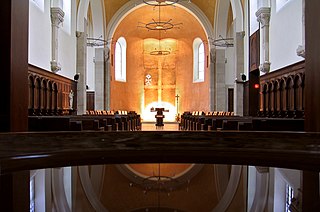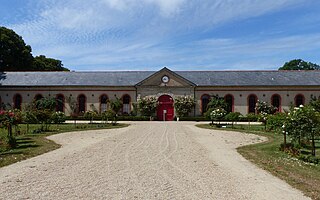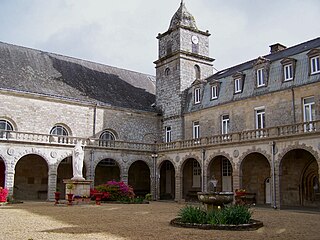History
Notre-Dame-de-Joye Abbey was founded on October 5, 1275 by Blanche de Champagne [ fr ], wife of John I the Red (1217-† 1286), Duke of Brittany, and mother of John II (1239 - 1305), Duke of Brittany. The abbey was ravaged by fire in 1512. It was rebuilt in 1693.
The abbey's 17th-century buildings include the gatehouse, the abbot's dwelling and a farm building. In the 19th century, a south wing was added to these buildings.
The site was chosen to become one of France's national stud farms. The choice was initially between the Ursulines de Pontivy enclosure, and the Abbey of Notre-Dame de Langonnet, which was chosen to become a stud farm, but the Langonnet abbey was returned to the Spiritans in 1860 when the stallion depot was moved to Hennebont, around the Abbey de la Joie [1] .
Recumbent statue of Blanche de Champagne Abbey of La Joie-Notre-Dame in
Hennebont now in the Louvre Museum.
[2]
The first abbess was Sibille de Beaugé (died 1320), daughter of Renaud sire de Beaugé and Sibille de Beaujeu, and first cousin of Duchess Blanche, who occupied the abbey with sisters from the Saint-Antoine-des-Champs abbey in Paris. In 1279, however, the abbey was affiliated to L'Aumône Abbey in the diocese of Chartres, like other Breton Cistercian abbeys. The abbey was rebuilt and enlarged in the seventeenth century (1693), after a fire destroyed the church, sacristy, chapter house, dormitory above and a large part of the cloister on July 25, 1510.
During the French Revolution, following the expulsion of the last abbess and nuns in October 1792, the abbey church was turned over to quarrymen.
In 1835, an "iron factory" was set up in the remaining buildings (abbey dwelling, refectory, dormitories and part of the cloister). When the factory was dismantled, all that remained were the Confessors' house, the abbot's dwelling and a farm building.
Around 1840, the whole complex became private property. The name "Porterie", given to the Maison des Confesseurs, dates from this period. This small pavilion, rebuilt in 1699, as attested by the date engraved on the pediment of one of the dormer windows, was originally the residence of the priests in charge of the Divine Office for the nuns. With the canalization of the Blavet, the installation of the factory and its subsequent transformation into a private residence, the pavilion became one of the entrances and was henceforth known as the porterie.
The Maison des Confesseurs, acquired and restored by the town of Hennebont, has become a place of residence for artists, writers, playwrights, etc., as part of the town's cultural projects. [3]
At the end of the 17th century, Abbess Suzanne de Plœuc commissioned the construction of a new building, the logis abbatial. Of this building, which bears the date 1693 in several places, two main buildings remain, forming an "L" shape. The third is a chapel built after 1840. The abbess's private garden lies to the west of the complex.
In 1856, the National Stud moved to the upper plateau above the abbey site. In 1920, the Haras department, which had taken over the site, installed horse stalls on the first floor, in the salons of the abbey dwelling. The grooms were housed upstairs and in the Confessors' house.

















